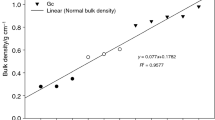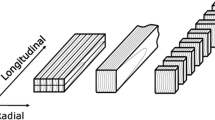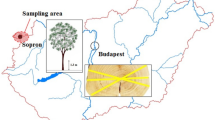Abstract
The aim of this paper was to investigate pore-size distributions in the nano-diameter range of wood and their alteration due to thermal modification of wood using thermoporosimetry, and to find out what consequences can be derived regarding the biological durability. Thermoporosimetry is a technique that is based on the measurement using differential scanning calorimetry (DSC). The method is based on the fact that frozen water contained within small pores is at elevated pressure and therefore has a depressed melting temperature as a function of the appropriate pore diameter. In addition, the fiber saturation points (FSP) were determined by DSC. The former were performed in an isothermal-step method and the latter using the continuous heating-up method. Native and thermally modified twin samples of Norway spruce (Picea abies (L.) Karst.), Sycamore maple (Acer pseudoplatanus L.) and European ash (Fraxinus excelsior L.) were analyzed. The results clearly show that the pore shares of wood for the measurable diameter range between 4 and 400 nm decrease considerably in all studied wood species due to thermal modification of the wood. Furthermore, thermal modification of wood leads to a decreased FSP for all studied wood species. For evaluation as well as reproducibility of the results of pore-size distribution and FSP, the consideration of sensible heat and specific heat of fusion plays an important role. If this is not done, it can lead to misinterpretations.







Similar content being viewed by others
References
Almeida G, Hernández RE (2006) Changes in physical properties of tropical and temperate hardwoods below and above the fiber saturation point. Wood Sci Technol 40:599–613
Aristov YI, Kovalevskaya YA, Tokarev MM, Paukov IE (2010) Low temperature heat capacity of the system “silica gel–calcium chloride–water”. J Therm Anal Calorim 103:773–778
Babiak M, Kudela J (1995) A contribution to the definition of the fiber saturation point. Wood Sci Technol 29:217–226
Chen CM, Wangaard F (1968) Wettability and the hysteresis effect in the sorption of water vapor by wood. Wood Sci Technol 2:177–187
Dieste A, Krause A, Mai C, Sèbe G, Grelier S, Militz H (2009) Modification of Fagus sylvatica L. with 1,3-dimethylol-4,5-dihydroxy ethylene urea (DMDHEU). Part 2: pore size distribution determined by differential scanning calorimetry. Holzforschung 63:89–93
Fahlén J, Salmén L (2005) Ultrastructural changes in a holocellulose pulp revealed by enzymes, thermoporosimetry and atomic force microscopy. Holzforschung 59:589–597
Hill CAS (2006) Wood modification. Chemical thermal and other processes. Wiley, Chichester
Hill CAS (2008) The reduction in the fibre saturation point of wood due to chemical modification using anhydride reagents: a reappraisal. Holzforschung 62:423–428
Hill CAS, Forster SC, Farahani MRM, Hale MDC, Ormondroyd GA, Williams GR (2005) An investigation of cell wall micropore blocking as a possible mechanism for the decay resistance of anhydride modified wood. Int Biodeterior Biodegrad 55:69–76
Kollmann F, Fengel D (1965) Änderungen der chemischen Zusammensetzung von Holz durch thermische Behandlung. Holz Roh Werkst 23:461–468
Książczak A, Radomski A, Zielenkiewicz T (2003) Nitrocellulose porosity—thermoporometry. J Therm Anal Calorim 74:559–568
Kürschner K, Melcerová A (1965) Über die chemischen Veränderungen des Buchenholzes bei thermischer Behandlung. Teil I. Chemische Veränderungen von Sägespänen bei 1-28 tägiger Erhitzung auf 80–160 °C. Holzforschung 19:161–171
Landry M (2005) Thermoporometry by differential scanning calorimetry: experimental considerations and applications. Thermochim Acta 433:27–50
Lekounougou S (2009) Effect of heat treatment on extracellular enzymatic activities involved in beech wood degradation by Trametes versicolor. Wood Sci Technol 43:331–341
Maloney T (2000) Messen der Porengrößenverteilung mittels DSC. UserCom Mettler Toledo 12:15–17
Maloney TC, Paulapuro H (1999) The formation of pores in the cell wall. J Pulp Pap Sci 25:430–436
Park S, Venditti R, Jameel H, Pawlak J (2006) Changes in pore size distribution during the drying of cellulose fibers as measured by differential scanning calorimetry. Carbohydr Polym 66:97–103
Peters J, Fischer K, Fischer S (2008) Characterization of emissions from thermally modified wood and their reduction by chemical treatment. Bioresources 3:491–502
Pétrissans A, Younsi R, Chaouch M, Gérardin P, Pétrissans M (2012) Experimental and numerical analysis of wood thermodegradation: mass loss kinetics. J Therm Anal Calorim 109:907–914
Repellin V, Guyonnet R (2005) Evaluation of heat-treated wood swelling by differential scanning calorimetry in relation to chemical composition. Holzforschung 59:28–34
Roffael E, Kraft R (2012) Einfluss der thermischen Modifizierung von Holz auf das Wasserrückhaltevermögen (WRV-Wert). Eur J Wood Prod 70:393–395
Siau J (1995) Wood: influence of moisture on physical properties. Virginia Polytechnic Institute and State University, VA
Simpson L, Barton AFM (1991) Determination of the fibre saturation point in whole wood using differential scanning calorimetry. Wood Sci Technol 25:301–308
Stephan P, Schaber K, Stephan K, Mayinger F (2010) Thermodynamik. Grundlagen und Technische Anwendungen. Springer, Heidelberg
Tjeerdsma BF, Boonstra M, Pizzi A, Tekely P, Militz H (1998) Characterisation of thermally modified wood: molecular reasons for wood performance improvement. Holz Roh Werkst 56:149–153
Topgaard D, Söderman O (2002) Self-diffusion of nonfreezing water in porous carbohydrate polymer systems studied with nuclear magnetic resonance. Biophys J 83:3596–3606
Wagenführ A, Scholz F (2007) Taschenbuch der Holztechnik. Hanser Fachbuch, München
Weise U, Maloney T, Paulapuro H (1996) Quantification of water in different states of interaction with wood pulp fibres. Cellulose 3:189–202
Zauer M (2011) Untersuchung zur Porenstruktur und kapillaren Wasserleitung im Holz und deren Änderung infolge einer thermischen Modifikation. Doctoral thesis, TU Dresden
Zauer M, Pfriem A, Wagenführ A (2013) Toward improved understanding of the cell-wall density and porosity of wood determined by gas pycnometry. Wood Sci Technol 47(6):1197–1211
Zelinka SL, Lambrecht MJ, Glass SV, Wiedenhoeft AC, Yelle DJ (2012) Examination of water phase transition in Loblolly pine and cell wall components by differential scanning calorimetry. Thermochim Acta 533:38–45
Acknowledgments
This publication is based on tests and results that were financially supported by the German Research Foundation (DFG WA 1540/7-2).
Author information
Authors and Affiliations
Corresponding author
Rights and permissions
About this article
Cite this article
Zauer, M., Kretzschmar, J., Großmann, L. et al. Analysis of the pore-size distribution and fiber saturation point of native and thermally modified wood using differential scanning calorimetry. Wood Sci Technol 48, 177–193 (2014). https://doi.org/10.1007/s00226-013-0597-9
Received:
Published:
Issue Date:
DOI: https://doi.org/10.1007/s00226-013-0597-9




